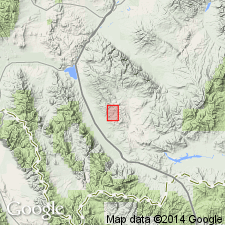
- Usage in publication:
-
- Red Butte conglomerate unit*
- Modifications:
-
- First used
- Dominant lithology:
-
- Conglomerate
- AAPG geologic province:
-
- Montana folded belt
Summary:
First published use as an informally named conglomerate that is stratigraphically the youngest conglomerate of Beaverhead Group in the Dell area, Beaverhead Co, MT in the Montana folded belt province. Was named in a thesis (Haley, 1986). Neither source of name nor type locality stated in this report. Rests on either of the older conglomerates of the Beaverhead with profound angular unconformity. These older conglomerates are the limestone-pebble conglomerate unit and the overlying quartzite roundstone conglomerate unit; these older conglomerates are similar to the Lima Conglomerate and the overlying Little Sheep conglomerate unit near Lima in the southwesternmost part of Beaverhead Co. Has a proximal facies of large boulders of Upper Mississippian, Pennsylvanian, Permian, and Triassic rocks derived from the adjacent Tendoy plate, and of boulders of limestone pebble conglomerate from the McKnight Canyon limestone unit and clasts of quartzite conglomerate. Is the only conglomerate of the Beaverhead to be derived from the Tendoy thrust sheet. Underlies middle to upper Eocene sediments and volcanics. May be early Tertiary age.
Source: GNU records (USGS DDS-6; Denver GNULEX).

- Usage in publication:
-
- Red Butte Conglomerate*
- Modifications:
-
- Named
- Reference
- Dominant lithology:
-
- Conglomerate
- Sandstone
- Siltstone
- AAPG geologic province:
-
- Montana folded belt
Summary:
Named top formation of Beaverhead Group for Red Butte, near Dell, Beaverhead Co, MT, Montana folded belt province. Type area: E1/2 sec 10, T13S, R9W. Formerly mapped as several unnamed lithologies in Beaverhead, Red Butte conglomerate unit, and as part of informal Lima limestone conglomerate, McKnight conglomerate, Chute Canyon sandstone. Present in 2 outcrop belts on east and west sides of Red Rock valley between Ashbough Canyon and Red Butte. Geologic map. Unconformably overlies unnamed quartzite conglomerate or an older limestone conglomerate of Beaverhead. Overlain by basalt and gravel of Tertiary Sage Creek Formation; contact unconformable or faulted. Dominated by boulder and cobble conglomerate. Minor interbeds of sandstone and siltstone. Unusual assemblage of coarse, angular, recycled clasts mostly Mississippian through Triassic limestones, and Middle Proterozoic Belt quartzite less than 25% of clast population. Well-cemented limestone conglomerate clasts make up less than 10% of total clasts locally. Largest boulders, and the only boulders over 1 m long are of reworked limestone conglomerate. No section complete; 204 m thick at type; 305 m thick in Chute Canyon reference section. Deposited in ephemeral flood and debris-flow dominated fans. Source area: Blacktail-Snowcrest uplift (east) or thrust sheet (west). Stratigraphic chart. Maastrichtian and early Tertiary? (Paleocene) age likely; early Eocene age possible.
Source: GNU records (USGS DDS-6; Denver GNULEX).
For more information, please contact Nancy Stamm, Geologic Names Committee Secretary.
Asterisk (*) indicates published by U.S. Geological Survey authors.
"No current usage" (†) implies that a name has been abandoned or has fallen into disuse. Former usage and, if known, replacement name given in parentheses ( ).
Slash (/) indicates name conflicts with nomenclatural guidelines (CSN, 1933; ACSN, 1961, 1970; NACSN, 1983, 2005, 2021). May be explained within brackets ([ ]).

